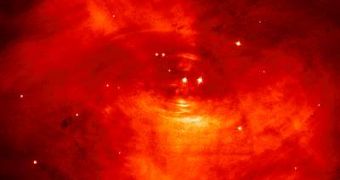The Geminga pulsar was created about 340,000 years ago through the supernova explosion of a regular star, inside what is now called the Geminga supernova. It is well known that supernovae can provide with the required energy to accelerate energetic elementary particles into interstellar space, the so-called cosmic rays, however the process was never actually directly linked to supernovae.
Now, a couple of astronomers from the Arcetri Astrophysical Observatory in Florence and the National Institute for Astrophysics in Palermo, namely Marco Salvati and Bruno Sacco, have found clear evidence that the Geminga supernova could have created a shock wave powerful enough to energize protons to shear massive magnitudes. While most of the cosmic rays cannot be identified with the point of origin due to the fact the they are greatly influenced by interactions with magnetic fields, the Geminga cosmic rays seem to point right back to their place of birth.
The Geminga cosmic rays produce a slight excess of cosmic rays in one part of the Earth's sky, but although they have been traveling for the last 340,000 years into interstellar space, they can still be easily pinpointed and identified with their source. During the experiment which took place in Palermo, the scientists observed that there was a TeV cosmic ray excess in the direction of the heliotail, a location near the Galactic anti-Center.
All evidence show that the energy burst could have not originated from anywhere else except from the Geminga pulsar supernova explosion. It is approximated that the amount of energy ejected during the creating of the cosmic ray emission was about E+49 erg (or 10 followed by 49 zeros), which is roughly equivalent to only 0.01 percent of the energy released by an ordinary supernova explosion.
By confirming the cosmic rays diffusion, according to Bohm's prescription, and the radial velocity required to create the Geminga pulsar, the Italian team found that their presumption was in direct concordance with the information regarding the Geminga pulsar. Geminga pulsar radial velocity has been previously predicted through a series of studies investigating the formation of the Local Bubble. On the other hand, there is a small probability that the cosmic ray anomaly does not originate from Geminga, meaning that the search for cosmic rays and their source would be basically put to a halt.

 14 DAY TRIAL //
14 DAY TRIAL //